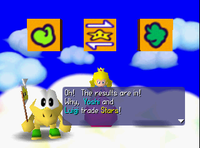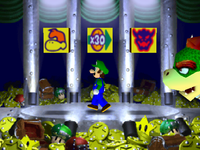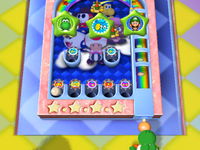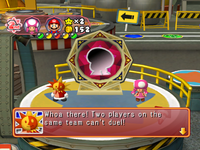Chance Time: Difference between revisions
Luigifan18 (talk | contribs) (Grammar check) |
(total rewrite, including the possible transactions compiled from a bunch of videos) |
||
| Line 1: | Line 1: | ||
{{ | {{image|games missing: MP3, MP5, MPSS}} | ||
'''Chance Time''' is a board event in [[Mario Party (series)|the Mario Party series]] triggered by landing on a [[Chance Time Space]]. The player landing on the space plays a small minigame that transfers [[coin]]s or [[Star]]s between themselves or other players. Chance Time has the potential to drastically alter the course of a game, making it a very risky gamble. | |||
'''Chance Time''' is | |||
==Specifics== | |||
===''Mario Party''=== | |||
[[Image:MP1 Chance Time.png|thumb|right|Results of Chance Time in ''Mario Party'']] | |||
The first ''[[Mario Party]]'' establishes Chance Time as rolling three Dice Blocks, lined up from left to right. The left and right blocks correspond to the four characters in the game, while the middle one specifies how many coins or Stars one must give to the other. The player landing on the "! Space" can roll the dice in any order. Selecting a character on either side block will remove the character from the other side, so they cannot appear on both at once. The blocks speed up after each roll; it is fairly easy to select a specific outcome for the first roll, but rather difficult for the second, and practically impossible for the third. | |||
In | In addition, one of the possible [[Bowser Space]] events is '''Bowser's Chance Time'''. Here, the blocks spin uncontrollably fast from the outset, the middle block's options are to only give coins from left to right, and the right block is preset to Bowser. If the loser has no coins, Bowser will give them 10 coins out of pity. | ||
The possible transactions include: | |||
* 10 coins → | |||
* ← 10 coins | |||
* 20 coins → | |||
* ← 20 coins | |||
* 30 coins → | |||
* ← 30 coins | |||
* 1 Star → | |||
* ← 1 Star | |||
* ↔ all coins | |||
* ↔ all Stars | |||
===''Mario Party 2''=== | |||
[[Image:Bowser Chance Time.png|thumb|right|Bowser's Chance Time in ''Mario Party 2'']] | |||
Chance Time in ''[[Mario Party 2]]'' is mostly unchanged from the previous game. The main difference is that the middle block no longer has a fixed order of results, so to get something in particular is more difficult. | |||
Bowser's Chance Time also appears, and remains unchanged. | |||
The possible transactions include: | |||
* 3 coins → (only during the first 5 turns) | |||
* ← 3 coins (only during the first 5 turns) | |||
* 10 coins → (only during Bowser's Chance Time) | |||
* 20 coins → | |||
* ← 20 coins | |||
* 30 coins → | |||
* ← 30 coins | |||
* 40 coins → (only during Bowser's Chance Time) | |||
* 1 Star → | |||
* ← 1 Star | |||
* ↔ all coins | |||
* ↔ all Stars | |||
* ↔ all coins and Stars (only after the first 5 turns) | |||
===''Mario Party 3''=== | |||
In ''[[Mario Party 3]]'', the general mechanics of Chance Time are mostly the same, but with a significant change: the player does not have control of which order they hit the blocks. Instead, they strike a single block attached to a slot machine-like device, with it being predetermined which block will stop. The game also specifies who the giver and receiver are, rather than either direction being possible, and there are no "swap" options. | |||
The possible transactions include: | |||
* 1 coin → | |||
* 10 coins → (only before the last 5 turns) | |||
* 20 coins → | |||
* 30 coins → (only after the first 5 turns) | |||
* 1 Star → | |||
* 2 Stars → | |||
* 3 Stars → (only after the first 5 turns) | |||
* all coins → | |||
* all Stars → | |||
===''Mario Party 4''=== | |||
[[Image:Mp4fortunespace6.png|thumb|right|The Reversal of Fortune as seen in ''Mario Party 4'']] | |||
''[[Mario Party 4]]'' reworks Chance Time into '''Reversal of Fortune'''. Instead of hitting blocks, the player uses a pinball machine to launch a ball into a slot that determines what happens. For each of three pinball boards, the player can choose how much power to launch the ball with using the {{button|gcn|Stick}}, pressing {{button|gcn|A}} to launch the ball. The game also applies a significant random component to the ball strength, so it is not possible for the player to control what happens in any feasible way. The order is also fixed; the giver is always chosen first, followed by the receiver, and then the amount. | |||
The possible transactions include: | |||
* 20 coins → | |||
* 1 Star → | |||
* 2 Stars → | |||
* ↔ all coins | |||
* ↔ all Stars | |||
* ↔ all coins and Stars | |||
===''Mario Party 5''=== | |||
'''Chance Roulette''' in ''[[Mario Party 5]]'' behaves much like in ''Mario Party 3''; the player hits a single block to determine the three results in a predetermined order. Like in ''Mario Party 4'', the order is fixed to "left, right, middle", and the roulette cycles too quickly for the player to time anything on purpose. The main difference is that there is a significant bias towards the left side being the receiver, rather than it being equally likely for wealth to be going in either direction. In addition, if the player activates the event by using a [[Chance Capsule]] on themselves (for 20 coins), they are automatically placed on the left side. As a result, a self-used capsule applies a notable boost in the chances of something good happening to the player. | |||
The possible transactions include: | |||
* 20 coins → | |||
* ← 20 coins | |||
* ← 1 Star | |||
* ← 2 Stars | |||
* ↔ all coins | |||
* ↔ all Stars | |||
* ↔ all coins and Stars | |||
===''Mario Party 6''=== | |||
[[Image:Round of Miracles - MP6.png|thumb|Right|The Round of Miracles]] | |||
'''Round of Miracles''' in ''[[Mario Party 6]]'' is effectively identical to in ''Mario Party 5''. | |||
The possible transactions include: | |||
* 20 coins → | |||
* 1 Star → | |||
* 2 Stars → | |||
* ↔ all coins | |||
* ↔ all Stars | |||
* ↔ all coins and Stars | |||
===''Mario Party Superstars''=== | |||
After a long absence, Chance Time returns in ''[[Mario Party Superstars]]''. It behaves identically to the original ''Mario Party'' iteration, with three blocks of fixed cycle that start slow and speed up and can be hit in any order. | |||
The possible transactions include: | |||
* 3 coins → | |||
* ← 3 coins | |||
* 20 coins → | |||
* ← 20 coins | |||
* 30 coins → | |||
* ← 30 coins | |||
* 1 Star → | |||
* ← 1 Star | |||
* ↔ all coins | |||
* ↔ all Stars | |||
* ↔ all coins and Stars | |||
{{br}} | {{br}} | ||
| Line 42: | Line 132: | ||
[[Category:Mario Party 5]] | [[Category:Mario Party 5]] | ||
[[Category:Mario Party 6]] | [[Category:Mario Party 6]] | ||
[[Category:Mario Party Superstars]] | |||
Revision as of 13:24, January 16, 2022
It has been requested that at least one image be uploaded for this article. Remove this notice only after the image(s) have been added. Specific(s): games missing: MP3, MP5, MPSS
Chance Time is a board event in the Mario Party series triggered by landing on a Chance Time Space. The player landing on the space plays a small minigame that transfers coins or Stars between themselves or other players. Chance Time has the potential to drastically alter the course of a game, making it a very risky gamble.
Specifics
Mario Party
The first Mario Party establishes Chance Time as rolling three Dice Blocks, lined up from left to right. The left and right blocks correspond to the four characters in the game, while the middle one specifies how many coins or Stars one must give to the other. The player landing on the "! Space" can roll the dice in any order. Selecting a character on either side block will remove the character from the other side, so they cannot appear on both at once. The blocks speed up after each roll; it is fairly easy to select a specific outcome for the first roll, but rather difficult for the second, and practically impossible for the third.
In addition, one of the possible Bowser Space events is Bowser's Chance Time. Here, the blocks spin uncontrollably fast from the outset, the middle block's options are to only give coins from left to right, and the right block is preset to Bowser. If the loser has no coins, Bowser will give them 10 coins out of pity.
The possible transactions include:
- 10 coins →
- ← 10 coins
- 20 coins →
- ← 20 coins
- 30 coins →
- ← 30 coins
- 1 Star →
- ← 1 Star
- ↔ all coins
- ↔ all Stars
Mario Party 2
Chance Time in Mario Party 2 is mostly unchanged from the previous game. The main difference is that the middle block no longer has a fixed order of results, so to get something in particular is more difficult.
Bowser's Chance Time also appears, and remains unchanged.
The possible transactions include:
- 3 coins → (only during the first 5 turns)
- ← 3 coins (only during the first 5 turns)
- 10 coins → (only during Bowser's Chance Time)
- 20 coins →
- ← 20 coins
- 30 coins →
- ← 30 coins
- 40 coins → (only during Bowser's Chance Time)
- 1 Star →
- ← 1 Star
- ↔ all coins
- ↔ all Stars
- ↔ all coins and Stars (only after the first 5 turns)
Mario Party 3
In Mario Party 3, the general mechanics of Chance Time are mostly the same, but with a significant change: the player does not have control of which order they hit the blocks. Instead, they strike a single block attached to a slot machine-like device, with it being predetermined which block will stop. The game also specifies who the giver and receiver are, rather than either direction being possible, and there are no "swap" options.
The possible transactions include:
- 1 coin →
- 10 coins → (only before the last 5 turns)
- 20 coins →
- 30 coins → (only after the first 5 turns)
- 1 Star →
- 2 Stars →
- 3 Stars → (only after the first 5 turns)
- all coins →
- all Stars →
Mario Party 4
Mario Party 4 reworks Chance Time into Reversal of Fortune. Instead of hitting blocks, the player uses a pinball machine to launch a ball into a slot that determines what happens. For each of three pinball boards, the player can choose how much power to launch the ball with using the ![]() , pressing
, pressing ![]() to launch the ball. The game also applies a significant random component to the ball strength, so it is not possible for the player to control what happens in any feasible way. The order is also fixed; the giver is always chosen first, followed by the receiver, and then the amount.
to launch the ball. The game also applies a significant random component to the ball strength, so it is not possible for the player to control what happens in any feasible way. The order is also fixed; the giver is always chosen first, followed by the receiver, and then the amount.
The possible transactions include:
- 20 coins →
- 1 Star →
- 2 Stars →
- ↔ all coins
- ↔ all Stars
- ↔ all coins and Stars
Mario Party 5
Chance Roulette in Mario Party 5 behaves much like in Mario Party 3; the player hits a single block to determine the three results in a predetermined order. Like in Mario Party 4, the order is fixed to "left, right, middle", and the roulette cycles too quickly for the player to time anything on purpose. The main difference is that there is a significant bias towards the left side being the receiver, rather than it being equally likely for wealth to be going in either direction. In addition, if the player activates the event by using a Chance Capsule on themselves (for 20 coins), they are automatically placed on the left side. As a result, a self-used capsule applies a notable boost in the chances of something good happening to the player.
The possible transactions include:
- 20 coins →
- ← 20 coins
- ← 1 Star
- ← 2 Stars
- ↔ all coins
- ↔ all Stars
- ↔ all coins and Stars
Mario Party 6
Round of Miracles in Mario Party 6 is effectively identical to in Mario Party 5.
The possible transactions include:
- 20 coins →
- 1 Star →
- 2 Stars →
- ↔ all coins
- ↔ all Stars
- ↔ all coins and Stars
Mario Party Superstars
After a long absence, Chance Time returns in Mario Party Superstars. It behaves identically to the original Mario Party iteration, with three blocks of fixed cycle that start slow and speed up and can be hit in any order.
The possible transactions include:
- 3 coins →
- ← 3 coins
- 20 coins →
- ← 20 coins
- 30 coins →
- ← 30 coins
- 1 Star →
- ← 1 Star
- ↔ all coins
- ↔ all Stars
- ↔ all coins and Stars
Official profiles
Mario Party 2
- Wii Virtual Console manual: "Begins when you land on a ! Space. When you hit a block that has a picture of a character on it, the coins or stars you have increase or decrease depending on the picture that comes up."
Names in other languages
| Language | Name | Meaning | Notes |
|---|---|---|---|
| Italian | (S)Fortuna[?] | (Un)Luck | |
| Portuguese | Hora da Verdade[?] | Moment of Truth |
Trivia
- The box art for Mario Party shows a Chance Time die with Luigi, Bowser, and Star symbols. However, it is not possible for a Chance Time die to have all these symbols at once. There is a die for the playable characters, a die for Stars and Coins, and a Bowser-only die that's exclusive to Bowser's Chance Time.



